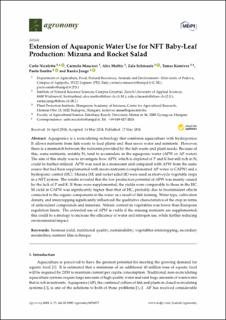Bitte benutzen Sie diese Kennung, um auf die Ressource zu verweisen:
https://doi.org/10.21256/zhaw-4950| Publikationstyp: | Beitrag in wissenschaftlicher Zeitschrift |
| Art der Begutachtung: | Peer review (Publikation) |
| Titel: | Extension of aquaponic water use for NFT baby-leaf production : mizuna and rocket salad |
| Autor/-in: | Nicoletto, Carlo Maucieri, Carmelo Mathis, Alex Schmautz, Zala Komives, Tamas Sambo, Paolo Junge, Ranka |
| DOI: | 10.21256/zhaw-4950 10.3390/agronomy8050075 |
| Erschienen in: | Agronomy |
| Band(Heft): | 8 |
| Heft: | 5 |
| Seite(n): | 75 |
| Erscheinungsdatum: | 17-Mai-2018 |
| Verlag / Hrsg. Institution: | MDPI |
| ISSN: | 2073-4395 |
| Sprache: | Englisch |
| Fachgebiet (DDC): | 630: Landwirtschaft |
| Zusammenfassung: | Aquaponics is a recirculating technology that combines aquaculture with hydroponics. It allows nutrients from fish waste to feed plants and thus saves water and nutrients. However, there is a mismatch between the nutrients provided by the fish waste and plant needs. Because of this, some nutrients, notably N, tend to accumulate in the aquaponic water (APW or AP water). The aim of this study was to investigate how APW, which is depleted of P and K but still rich in N, could be further utilized. APW was used in a mesocosm and compared with APW from the same source that had been supplemented with macro-nutrients (complemented AP water or CAPW) and a hydroponic control (HC). Mizuna (M) and rocket salad (R) were used as short-cycle vegetable crops in a NFT system. The results revealed that the low production potential of APW was mainly caused by the lack of P and K. If these were supplemented, the yields were comparable to those in the HC. M yield in CAPW was significantly higher than that of HC, probably due to biostimulant effects connected to the organic components in the water as a result of fish farming. Water type, cultivation density, and intercropping significantly influenced the qualitative characteristics of the crop in terms of antioxidant compounds and minerals. Nitrate content in vegetables was lower than European regulation limits. The extended use of APW is viable if the missing nutrients are supplemented; this could be a strategy to increase the efficiency of water and nitrogen use, while further reducing environmental impact. |
| URI: | https://digitalcollection.zhaw.ch/handle/11475/14108 |
| Volltext Version: | Publizierte Version |
| Lizenz (gemäss Verlagsvertrag): | CC BY 4.0: Namensnennung 4.0 International |
| Departement: | Life Sciences und Facility Management |
| Organisationseinheit: | Institut für Umwelt und Natürliche Ressourcen (IUNR) |
| Enthalten in den Sammlungen: | Publikationen Life Sciences und Facility Management |
Dateien zu dieser Ressource:
| Datei | Beschreibung | Größe | Format | |
|---|---|---|---|---|
| 2018_Nicoletto_Extension_of_aquaponic_water_use_for_NFT_baby.pdf | 5.86 MB | Adobe PDF |  Öffnen/Anzeigen |
Zur Langanzeige
Nicoletto, C., Maucieri, C., Mathis, A., Schmautz, Z., Komives, T., Sambo, P., & Junge, R. (2018). Extension of aquaponic water use for NFT baby-leaf production : mizuna and rocket salad. Agronomy, 8(5), 75. https://doi.org/10.21256/zhaw-4950
Nicoletto, C. et al. (2018) ‘Extension of aquaponic water use for NFT baby-leaf production : mizuna and rocket salad’, Agronomy, 8(5), p. 75. Available at: https://doi.org/10.21256/zhaw-4950.
C. Nicoletto et al., “Extension of aquaponic water use for NFT baby-leaf production : mizuna and rocket salad,” Agronomy, vol. 8, no. 5, p. 75, May 2018, doi: 10.21256/zhaw-4950.
NICOLETTO, Carlo, Carmelo MAUCIERI, Alex MATHIS, Zala SCHMAUTZ, Tamas KOMIVES, Paolo SAMBO und Ranka JUNGE, 2018. Extension of aquaponic water use for NFT baby-leaf production : mizuna and rocket salad. Agronomy. 17 Mai 2018. Bd. 8, Nr. 5, S. 75. DOI 10.21256/zhaw-4950
Nicoletto, Carlo, Carmelo Maucieri, Alex Mathis, Zala Schmautz, Tamas Komives, Paolo Sambo, and Ranka Junge. 2018. “Extension of Aquaponic Water Use for NFT Baby-Leaf Production : Mizuna and Rocket Salad.” Agronomy 8 (5): 75. https://doi.org/10.21256/zhaw-4950.
Nicoletto, Carlo, et al. “Extension of Aquaponic Water Use for NFT Baby-Leaf Production : Mizuna and Rocket Salad.” Agronomy, vol. 8, no. 5, May 2018, p. 75, https://doi.org/10.21256/zhaw-4950.
Alle Ressourcen in diesem Repository sind urheberrechtlich geschützt, soweit nicht anderweitig angezeigt.